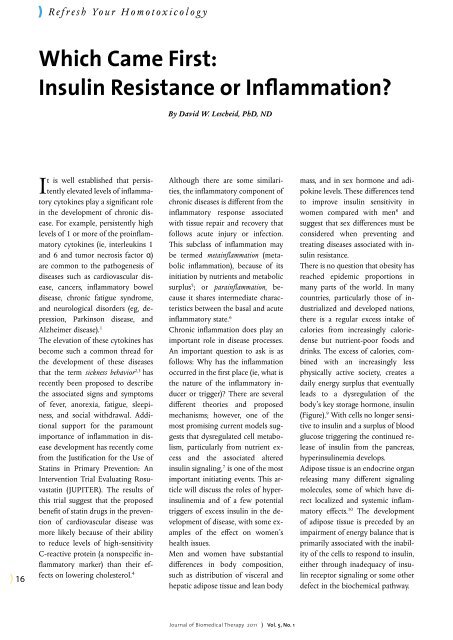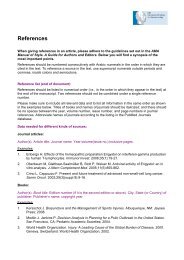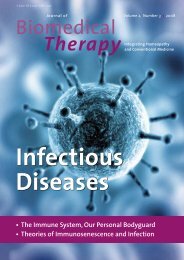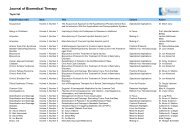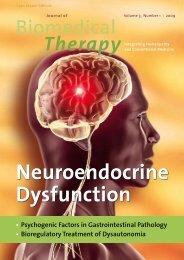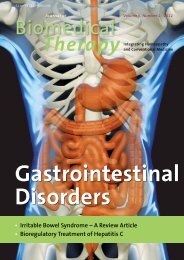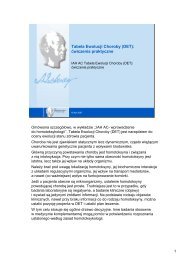Biomedical Therapy - International Academy of Homotoxicology
Biomedical Therapy - International Academy of Homotoxicology
Biomedical Therapy - International Academy of Homotoxicology
Create successful ePaper yourself
Turn your PDF publications into a flip-book with our unique Google optimized e-Paper software.
) 16<br />
) Refresh Your <strong>Homotoxicology</strong><br />
Which Came First:<br />
Insulin Resistance or Inflammation?<br />
It is well established that persistently<br />
elevated levels <strong>of</strong> inflammatory<br />
cytokines play a significant role<br />
in the development <strong>of</strong> chronic disease.<br />
For example, persistently high<br />
levels <strong>of</strong> 1 or more <strong>of</strong> the proinflammatory<br />
cytokines (ie, interleukins 1<br />
and 6 and tumor necrosis factor α)<br />
are common to the pathogenesis <strong>of</strong><br />
diseases such as cardiovascular disease,<br />
cancers, inflammatory bowel<br />
disease, chronic fatigue syndrome,<br />
and neurological disorders (eg, depression,<br />
Parkinson disease, and<br />
Alz heimer disease). 1<br />
The elevation <strong>of</strong> these cytokines has<br />
become such a common thread for<br />
the development <strong>of</strong> these diseases<br />
that the term sickness behavior2,3 has<br />
recently been proposed to describe<br />
the associated signs and symptoms<br />
<strong>of</strong> fever, anorexia, fatigue, sleepiness,<br />
and social withdrawal. Additional<br />
support for the paramount<br />
importance <strong>of</strong> inflammation in disease<br />
development has recently come<br />
from the Justification for the Use <strong>of</strong><br />
Statins in Primary Prevention: An<br />
Intervention Trial Evaluating Rosuvastatin<br />
(JUPITER). The results <strong>of</strong><br />
this trial suggest that the proposed<br />
benefit <strong>of</strong> statin drugs in the prevention<br />
<strong>of</strong> cardiovascular disease was<br />
more likely because <strong>of</strong> their ability<br />
to reduce levels <strong>of</strong> high-sensitivity<br />
C-reactive protein (a nonspecific inflammatory<br />
marker) than their effects<br />
on lowering cholesterol. 4<br />
By David W. Lescheid, PhD, ND<br />
Although there are some similarities,<br />
the inflammatory component <strong>of</strong><br />
chronic diseases is different from the<br />
inflammatory response associated<br />
with tissue repair and recovery that<br />
follows acute injury or infection.<br />
This subclass <strong>of</strong> inflammation may<br />
be termed metainflammation (metabolic<br />
inflammation), because <strong>of</strong> its<br />
initiation by nutrients and metabolic<br />
surplus 5 ; or parainflammation, because<br />
it shares intermediate characteristics<br />
between the basal and acute<br />
inflammatory state. 6<br />
Chronic inflammation does play an<br />
important role in disease processes.<br />
An important question to ask is as<br />
follows: Why has the inflammation<br />
occurred in the first place (ie, what is<br />
the nature <strong>of</strong> the inflammatory inducer<br />
or trigger)? There are several<br />
different theories and proposed<br />
mechanisms; however, one <strong>of</strong> the<br />
most promising current models suggests<br />
that dysregulated cell metabolism,<br />
particularly from nutrient excess<br />
and the associated altered<br />
insulin signaling, 7 is one <strong>of</strong> the most<br />
important initiating events. This article<br />
will discuss the roles <strong>of</strong> hyperinsulinemia<br />
and <strong>of</strong> a few potential<br />
triggers <strong>of</strong> excess insulin in the development<br />
<strong>of</strong> disease, with some examples<br />
<strong>of</strong> the effect on women’s<br />
health issues.<br />
Men and women have substantial<br />
differences in body composition,<br />
such as distribution <strong>of</strong> visceral and<br />
hepatic adipose tissue and lean body<br />
Journal <strong>of</strong> <strong>Biomedical</strong> <strong>Therapy</strong> 2011 ) Vol. 5, No. 1<br />
mass, and in sex hormone and adipokine<br />
levels. These differences tend<br />
to improve insulin sensitivity in<br />
women compared with men 8 and<br />
suggest that sex differences must be<br />
considered when preventing and<br />
treating diseases associated with insulin<br />
resistance.<br />
There is no question that obesity has<br />
reached epidemic proportions in<br />
many parts <strong>of</strong> the world. In many<br />
countries, particularly those <strong>of</strong> industrialized<br />
and developed nations,<br />
there is a regular excess intake <strong>of</strong><br />
calories from increasingly caloriedense<br />
but nutrient-poor foods and<br />
drinks. The excess <strong>of</strong> calories, combined<br />
with an increasingly less<br />
physically active society, creates a<br />
daily energy surplus that eventually<br />
leads to a dysregulation <strong>of</strong> the<br />
body’s key storage hormone, insulin<br />
(Figure). 9 With cells no longer sensitive<br />
to insulin and a surplus <strong>of</strong> blood<br />
glucose triggering the continued release<br />
<strong>of</strong> insulin from the pancreas,<br />
hyperinsulinemia develops.<br />
Adipose tissue is an endocrine organ<br />
releasing many different signaling<br />
molecules, some <strong>of</strong> which have direct<br />
localized and systemic inflammatory<br />
effects. 10 The development<br />
<strong>of</strong> adipose tissue is preceded by an<br />
impairment <strong>of</strong> energy balance that is<br />
primarily associated with the inability<br />
<strong>of</strong> the cells to respond to insulin,<br />
either through inadequacy <strong>of</strong> insulin<br />
receptor signaling or some other<br />
defect in the biochemical pathway.


